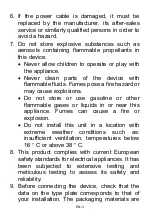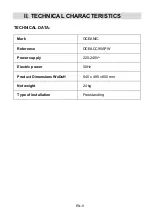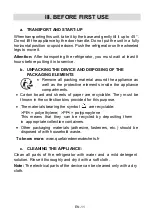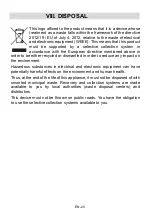
EN-1
7
VI.
CLEANING AND MAINTENANCE
ICING
The humidity brought by the products and by the ambient air causes over
time the formation of frost and ice in the apparatus. A thin layer of frost or
ice does not affect the operation of the freezer, but the thicker the layer
becomes, the higher the energy consumption. A thin layer of ice can be
removed with a plastic wiper.
Never use an electrical appliance or sharp object that could damage the
inside of the appliance.
When the frost or ice layer reaches a thickness of 4 to 5 mm, the freezer
must be defrosted. Defrosting is recommended when the freezer is near or
completely empty.
Proceed as follows:
1.
Unplug the unit.
2. Take out the frozen products. Keep them in a cool or well-wrapped
place to minimize defrosting as much as possible.
3.
Leave the lid open.
4.
Place a container of hot (non-boiling) water in the freezer, close the lid
and wait about 30 minutes, then remove the frost with a plastic scraper.
5.
To prevent overflowing of water on the floor during defrosting, monitor
the water collection tray. Cover the floor around the defrost water spout
to protect it from ice and splash. When all ice has melted, clean the
freezer with dishwashing liquid that is largely diluted with water. Wipe
with a soft cloth.
6.
Wait about five minutes after turning the machine back on before
putting frozen products back in.






































